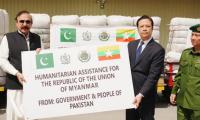In February, the US and the Taliban reached a landmark agreement that will likely end America’s longest war. The deal allows for Washington to pull out most of its troops and military advisors from Afghanistan, the insurgents to share power with the elected government in Kabul, and for the Taliban to sever ties with terror groups.
Although the three-part, 1,484-word agreement signed on February 29th between the US and the “Islamic Emirate of Afghanistan, also known as the Taliban,” covers the subjects of phased military withdrawals and counterinsurgency, it has three glaring omissions: there is not a single mention of the 2004 constitution, which grants equal rights to all Afghan citizens, regardless of their creed or gender. There is no reference to women, though they are the majority in Afghanistan. And there is nothing about the free press—or the constitutionally guaranteed freedom of expression granted to all Afghan citizens.
President Donald Trump has indicated that after he is done dealing with the coronavirus pandemic, he will meet Taliban leadership in person. According to the new agreement, this group, one of the most extremist and brutal on earth, will now have a say in who gets asylum, visas, passports, nationality, or even right of entry into and exit out of Afghanistan. Thousands of Taliban, many detained for heinous crimes against Afghan and Pakistani citizens and Western forces, have already been released as a part of this deal.
Despite the agreement, and in sync with the summer fighting season, violence is escalating. But the local reporting ecosystem stands atrophied, even ruptured. Afghanistan ranks at 122 and Pakistan is at 145 in the Paris-based Reporters San Frontiers World Press Freedom Index (both have dropped since 2019, from 121 and 142, respectively). The New York-based Committee to Protect Journalists says 46 journalists were killed in Afghanistan since 2001, and 57 in Pakistan. And the Islamabad-based Freedom Network estimates that of those killed in Pakistan, 33 were targeted in just the last seven years. Clearly, the state of journalists’ safety is on a dangerous trajectory.
This wasn’t always the case. With the advent of post-9/11 US military operations in the AfPak region, the press in both countries had flourished. Yes, war is hell, but with the war and American interest and investment came foreign news organizations, thousands of media jobs, expertise, technology, and most importantly, press freedom.
Of course, there were newspapers and radio stations and channels—less in “Af,” more in “Pak”—before the war, but they were mostly state-run or anemic. International investment, compounded by American presence and interest on the ground encouraged media deregulation in Pakistan, a rebirth of the press in Afghanistan, and gave the region’s journalists the muscle, momentum and inspiration to tell a larger story.
This post-9/11 generation of AfPak journalists used their newfound leverage to report on everything they could: women and voting, cricket and cuisine, graft and generals. As Islamabad and Kabul became regional news hubs (replacing New Delhi, Dubai, and Tehran) figures like Nobel Peace Prize laureate Malala Yousafzai, who started her journey by blogging about school for the BBC, emerged. So did great long-form storytellers like Ahmed Rashid, Oscar-winning documentarians like Sharmeen Obaid-Chinoy, and even popular fiction writers rooted in real events, like Mohammad Hanif, Mohsin Hamid and Khalid Hosseini.
But with war fatigue, as most foreign news outlets and associated non-governmental organizations wrap up operations and the war-dependent economies of both countries collapse, AfPak journalists and their institutions are weakened and abandoned, at the mercy of powerful interest-groups, anti-transparency state and quasi-state actors and, most recently and disturbingly, patrons like China, Turkey and Saudi Arabia.
Today, in Pakistan, as the influential military-dominated regime there continues to deliver on the crucial peace process by prodding Taliban leaders it houses and protects to the negotiating table with the Americans, it also uses the extra political mileage granted to it by the US to suppress journalists.
This includes the recent abduction of Matiullah Jan, an outspoken critic of the government and a self-declared media watchdog, Jan was “picked up” in Islamabad by men in uniform in broad daylight, only to be freed after footage of his kidnapping was caught on CCTV—evidence local journalists and regular citizens used as a rallying cry on social media to secure his release just twelve hours later.
An example of longer captivity is the ongoing detention without trial of Mir Shakil-ur-Rahman, the editor-in-chief of Pakistan’s largest media group, Jang/Geo. Despite his cooperation with investigators, Rahman has been in federal custody for over a 100 days now, based on charges framed for a land purchase deal he conducted 34 years ago; Rahman claims the charges are trumped up because his organization ran stories critical of the incumbent prime minister, Imran Khan. Interestingly, Khan appeared for years on Rahman’s fiercely independent news outlets as an opposition leader, and even used the Jang/Geo network to raise billions of rupees for his charity drives—but the rules are different now that he’s in power.
According to UNESCO’s observatory, two Pakistani reporters have been killed this year in the line of duty. I know of at least one case that it not included in its reports. Just after Jan’s abduction in late July, in my impoverished home province of Balochistan, which borders Afghanistan, local reporter Anwar Jan was gunned down as he walked home. Police are probing whether the hit was ordered by a government minister. Usually most such investigations end up with no arrests or convictions. It is why Afghanistan and Pakistan both feature regularly in the top 10 of the CPJ’s Global Impunity Index.
But beyond brutal violence, sophisticated new tools of finance and surveillance—legal as well as extra-legal, and inspired by the pandemic—are now the new non-violent weapons of choice for the Pakistani state for use against not just journalists or the networks they work for, but regular citizens as well.
In 2018, a curb was placed on the physical distribution of the print edition of the country’s largest and most influential English-language daily, Dawn. Since then, all of Pakistan’s publications and networks have been hit with new restrictions: the enhancement of “regulatory” (censorship) institutions, new rules for social media, and pre-qualifications for receiving ad revenues. Long before the pandemic, these state-built financial pressures caused dozens of newspapers, magazines, and channels to either shut down completely or resort to furloughs and layoffs. (Networks and journalists that do play along are taken care of.)
By design, not default, the system is rigged to push against journalism or journalists as soon as it gets the chance. The shocking release, by a Pakistani high court in the midst of coronavirus lockdown in March, of four men convicted for the kidnapping and beheading of Wall Street Journal reporter Daniel Pearl only underscores this point. (The convicts were “rearrested” after clear demands from the US and watchdogs.)
Journalists are not the only target of this new drive to stifle opinion. The fight for freedom has now stretched beyond the media, into the sphere of privacy and the rights of free expression guaranteed to all citizens under both the Afghan and Pakistani constitutions.
These fundamental rights stand threatened by newly-minted (and Ankara-Beijing-Riyadh-inspired) legislation that is being considered, replicated and implemented by both Islamabad and Kabul, especially targeting the digital freedoms of regular citizens.
The Pakistani government recently introduced harsh new social media measures—officially called the Citizen Protection (Against Online Harm) Rules 2020—that empower it to block any digital content or social platform it wishes with only 24 hours of notice. But, after some stern tweeting by the State Department, and in a rare show of unity with Pakistani civil society, an organized Asian coalition of Facebook, Google, and Twitter threatened to pull completely out of Pakistan if the government enacted the law (which has temporarily been shelved as a consequence of these protests).
Across the border, in Afghanistan, as the US starts a phased drawdown of roughly 12,000 troops —timed to coincide with the 2020 US election in November and likely to be marketed as a Trumpian success story—an upbeat White House and State Department can’t hide the increased concern on the ground over the release of thousands of Taliban, and the uncertain futures of Afghan journalists and their counterparts in civil society. Reporters San Frontiers warns that “women journalists are a favourite target, and are especially vulnerable in those regions where fundamentalist propaganda is heeded.” That’s code for where I hail from: the vast Pashtun belt, which straddles both southeastern Afghanistan and western Pakistan, and where the majority of Afghans live.
I’VE BEEN WATCHING THE LONG WAR since junior year of college, when I covered the fall of the Taliban regime from Kandahar and Balochistan for my college paper in Michigan. After graduating, I chose to be stationed in Pakistan but also watched Afghanistan, covering major events including elections, assassinations, cricket tournaments and counterinsurgency operations—over the last two decades. I’ve been embedded with almost a hundred units of the US, NATO, Afghan, and Pakistani militaries. In 2013, NBC assigned me to Afghanistan and tasked me to help wind down its Kabul bureau.
By then, ABC, CBS, and CNN had already left, and NBC was watered down to a resident stringer. According to my editors, the interest of American news-watching audiences was abating. A couple of years later, soon after the 2016 U.S. General Election, we finally got “the call”, telling us that Donald Trump had “sucked the oxygen” out of foreign news—and that this was a good time to reassess our futures.
I hung on for a couple more frustrating years saw more and more of my stories dropped, reporters fired and live-hits cancelled. After return my AfPak badge, I transitioned to more risk-averse options: spot news, local media, documentary, travelogue, and finally back to school: at Columbia, here in New York. With two daughters, dwindling editorially independent outlets to report for, and no safety net, I had to move, slow down, then stop.
But the stories haven’t stopped. The Taliban, according to skeptics in Islamabad, Kabul and Washington, are positioning themselves for a bloody civil war with the government while the Americans expedite their pull out. And the government, which has grudgingly agreed to the release of the Taliban prisoners, seems like it’s getting ready to dig in, even as the U.S. cuts aid and the militants keep up their offensive, despite the coronavirus pandemic.
Foreseeably, all sides will continue to claim victory and practice brinkmanship. That ambiguity will result in further confusion, which, history tells us, could lead to further conflict. The Long War will only get longer. But if it does, nobody will be around to cover it.
Courtesy: Colombia Journalism Review







